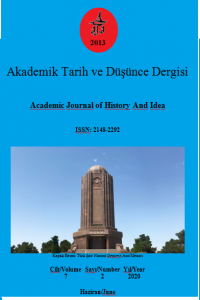Babürlü Sarayında Farsça Çalışmaları
Babürlüler Dönemi’nde Fars Dili, Ekber Şah, Cihangir Şah, Şah Cihan, Evrengzib Şah
Persıan Studıes at Baburıan Palace
Persian Language in Baburian Period, Akbar Shah, Jahangir Shah, Shah Jahan, Aurangzeb Shah,
___
- ABUL FAZL , 1968 , Ain-i-Akbari; Vol I, Iqtidar Alam Khan, “The Nobility under Akbar and the Development of His Religious policy, 1560-1580 A.B”, Journal of the Roval Asiatic Society. AFSHAN, Bokhari, 2009, “Gendered Landscapes‘: Jahan Ara Begum‘s (1614-1681) Patronage, Piety and Self-Representation in 17th C Mughal India” Doktora Tezi Viyana Üniversitesi, Sanat Tarihi Bölümü, Tez danışmanı Prof. Dr. Ebba Koch s. 34.
- ALAM, Muzaffar, 1998, “The Pursuit of Persian: Language in Mughal Politics” Author(s): Source: Modern Asian Studies, Vol. 32, No.2 Published by: Cambridge University Press, England, s. 317-349 URL: http://www.jstor.org/stable/313001 .Erişim: 15/02/2011. BADAYUNİ, Abdulkadir, 1979, Muntakhab-ut-Tewarikh: Vol II- III “translated by George S.A. Ranking, Mehra Ofset Press, Chandini Mahal, Delhi, India.
- BERNİER, François, 1891, Travels in the Mugal Empire, Archibald Constable, Colombia University Library, U.S.A.
- BEVİRİDGE, A.S, 1902, Babur-Nama or Memoirs of Babur, London, England.
- GHANİ, M. Abdul, 1930, A History of Persian Language and Literature at the Persian Court Part III, Indian Press, Allahabad, India.
- TOKER, Halil, 1995, “Hindistan’da Farsça ve Urduca Şiir, II. Bahadır Şah Devri Şairleri”, İstanbul Üniversitesi Fars Dili ve Ed. Blm. Tez danışmanı Prof. Dr. Nazif Hoca. s.42.
- MUMTAZ, Hasan, 1971, Iran and Pakistan: The Story of Cultural Relationship Through the Ages”, Karachi: Elite Publishers Ltd., Pakistan.
- SARKAR, Jadunath, 1919, Studies in Mughal India, Calcutta, India.
- JAFFAR, S.M, 1936, “The Mughal Empire from Babar to Aurangzeb”: A.L. Srivastava; Medieval Indian Culture: Sherwani; Cultural Trends in Medieval India, s.89-90.
- KHOSLA, R.P, 1976, Mughal Kingship and Nobility, İdare-i Edebiyat-ı Delhi, India.
- MUJEEB, M, 1967, The Indian Muslims, George Allen and Unwin Ltd.: London, England.
- PRASAD, Beni, 1940, History of Jahangir, Indian Press Limited, India.
- RİZVİ, S.A.S, 1975 “Religious and Intellectual History of the Muslims in Akbar’s Reign”, Harbans Mukhia; Historians and Historiography During the reign of Akbar, New Delhi, India. s.298.
- SAXENA, B.P, 1958, History of Shah Jahan of Delhi, Allahabad, Delhi, India.
- SRİVASTAVA, A.L, 1964, Medieval Indian Culture, Agarwala & Co. Ltd, Jaipur, India.
- SUGAM, Anand, 1992, History of Begum Nur Jahan, Radha Publication,, New Delhi, India.
- Yayın Aralığı: Yılda 6 Sayı
- Başlangıç: 2013
- Yayıncı: Hakan YILMAZ
Demokrat Parti Döneminde Sivil Bir Muhalif Örgüt Örneği: İleri Jön Türkler Birliği
Rumlaşan Selçuklular Sahte Ricatı Unuttu: Kösedağ Savaşı (3 Temmuz 1243)
Babürlü Sarayında Farsça Çalışmaları
Hacı Bayram Vəli Şeirlərində Özünüdərkin Struktur Troyektoriyası
Sofistlerin Epistemoljideki Yeri ve Önemi
Dede Korkut’ta Aile Kavramının Sosyal Genetiği Üzerine
Ekim Devriminden Sonra Türkmenistan’da İktidar Mücadelesi: Karşı Devrime Karşı Mücadele (1918-1919)
Rusya’nın Yeni Jeostratejisi ve Uluslararası Güvenlik
Özbekistandaki Tacikçe Gazetelerin Tarihi
